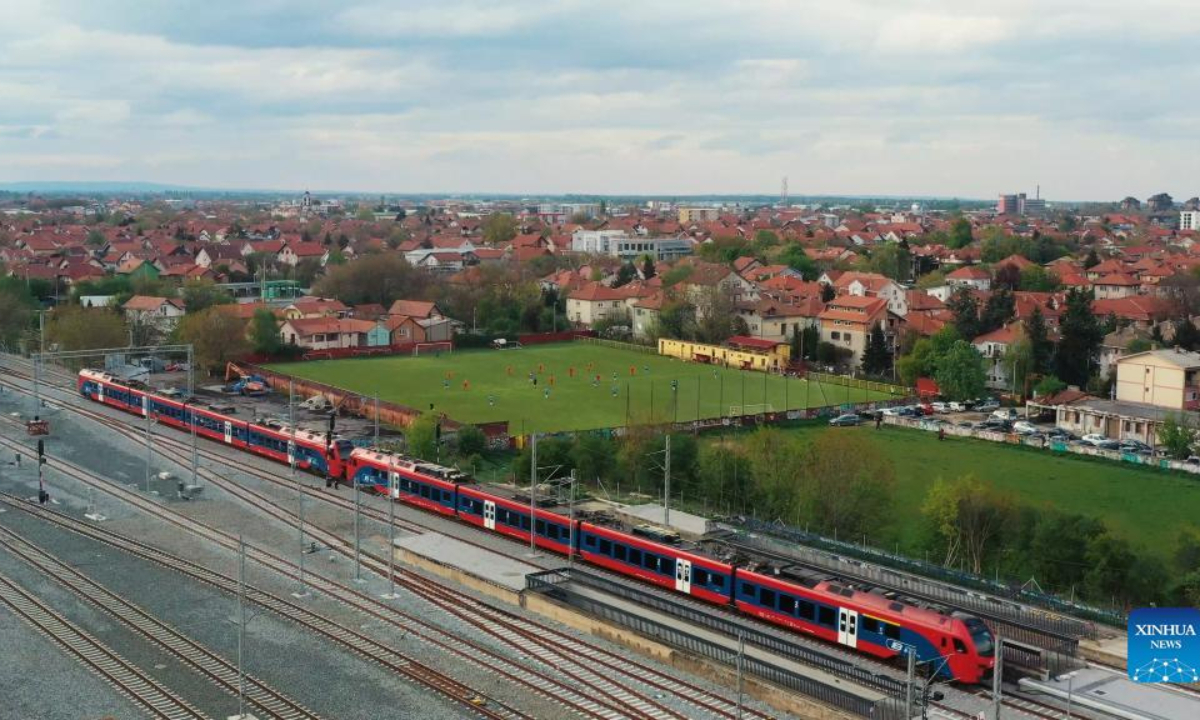
Aerial photo taken on April 23, 2022 shows the Belgrade-Novi Sad section of the Belgrade-Budapest railway in Belgrade, Serbia. Photo:Xinhua
In its first year, the operating section of the Belgrade-Budapest Railway, a high-speed railroad between the capitals of Serbia and Hungary, transported 2.93 million passengers as of Sunday.
The landmark project under China-proposed Belt and Road Initiative (BRI) has greatly facilitated travel by people, and it has become a flagship project of international railway cooperation.
A stretch of the Belgrade-Budapest Railway that connects Belgrade and Novi Sad in Serbia marked its first anniversary of operation on Sunday. More than 50 passenger trains run every day in the section, carrying an average of 8,200 passengers per day, according to statistics from China Railway International Group (CRI) sent to the Global Times on Sunday.
With a maximum operating speed of 200 kilometers an hour, the travel time between Belgrade and Novi Sad is reduced from 90 minutes to just 30 minutes. The line is also the first high-speed railway in Serbia.
A Belgrade resident named Marina was one of the passengers who enjoyed the high-speed service.
"I have taken the high-speed train to Novi Sad with my husband. It is very fast. It is a change in the way we travel, since we used to drive to Novi Sad. I'm looking forward to the operation of the whole line," Marina told the Global Times on Sunday.
For Sandor, a resident of Budapest, there is high expectation for the completion of the Belgrade-Budapest Railway.
"I am looking forward to the completion of the whole line. I will take the high-speed train from Budapest to Subotica as soon as the section opens," Sandor said on Sunday.
Subotica, a Serbian city bordering Hungary, is a planned station on the Belgrade-Budapest Railway and the Novi Sad-Subotica section is currently under construction.
Sandor said that he moved to Budapest with his parents from Subotica when he was three. "It now takes a long time to travel between the two capitals. If you got on the train at 10 pm in Budapest, then you would arrive in Belgrade at 7:30 am," said Sandor, adding that driving a car takes about six hours to travel between the two capitals.
Once completed, the travel time by high-speed rail will be shortened to two hours and 40 minutes.
CRI said that in the next step, it will make all-out efforts to promote the construction of the Novi Sad-Subotica section of the Belgrade-Budapest Railway in Serbia, and strive to complete it and put it into operation at an early date.
According to CRI, the north-south high-speed railway is a double-track electrified railway with a total length of 341.7 kilometers, including 183.1 kilometers in Serbia, with a designed maximum speed of 200 kilometers per hour, and 158.6 kilometers in Hungary, with a designed maximum speed of 160 kilometers per hour.
It is a major project to align high-quality BRI cooperation among China, Hungary and Serbia, a flagship project of China- Central and Eastern European Countries (CEEC) cooperation.
The Belgrade-Novi Sad section marks the first time that China-developed train control systems and technology are imported to Europe.
A large number of Chinese technologies and equipment, such as wireless communication systems, have also been applied in the railway. The Belgrade-Novi Sad section of the railway is more than 54 percent made-in-China, according to CRI.
The successful operation of the high-speed railway in its first year highlights its role as a mutually beneficial, open and win-win cooperation project, experts said.
The Belgrade-Budapest Railway will play an exemplary role in the CEEC region, promoting regional trade integration and cooperation, Sun Zhang, a railway expert from Shanghai Tongji University, told the Global Times on Sunday.
With the remaining section under construction, the Belgrade-Budapest Railway is also planned to be extended to Greece, which will deliver a direct connection to the Port of Piraeus and provide CEEC access to the Asian market. Therefore, the railway will form an international corridor, connecting Greece with Central and southeastern Europe, and providing cities along the route with access to the sea.
"The Belgrade-Budapest Railway, once completed and linked up with railways in Greece, will be a land-to-sea passage in Central Europe, offering unprecedented access to the sea for both Serbia and Hungary. Once shipments from these countries reach the open sea, they will be connected with the China-proposed 21st century maritime silk road," Sun said.
The designed speed of 200 kilometers per hour will accommodate both passenger and cargo transportation, and it will allow the railway to serve the role of a transportation artery, Sun said.
Sun predicted that ridership and cargo volume will grow exponentially once the passage from Budapest to Athens is fully completed.




